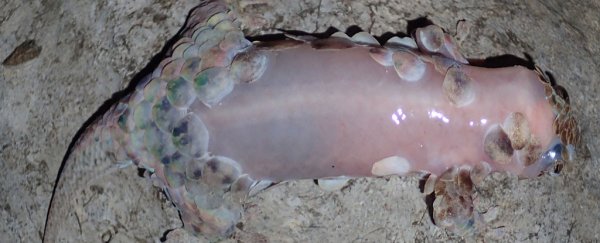When people get frightened by something, they're said to 'jump out of their own skin' – and this newly discovered gecko species shows there's actually a biological precedent for that.
Geckolepis megalepis is one of a number of 'fish-scale geckos' in the genus Geckolepis, which wear loosely attached scales that tear away to help them evade predators. While all geckos are known to perform the same survival trick, the newly identified G. megalepis takes 'rapid disrobing' to a whole other level.
"It looks like a fish until you grab it, and then it looks like a naked chicken breast," researcher Mark D. Scherz from the Ludwig Maximilian University of Munich in Germany told The New York Times.
Scherz and his team identified the Madagascar native as a standalone species in research published this week, and it's the first time a new member of the Geckolepis genus has been discovered in 75 years – in part because these slippery characters are just so darn hard to catch.
 F. Glaw
F. Glaw
What makes Geckolepis scales so readily detachable is that the plate of each scale is only loosely attached to the gecko's body along pre-defined 'tear zones' in the creature's skin.
G. megalepis's defence is superior to its cousins though, because its plating is made up of the largest scales of any fish-scale gecko – and geckos in general, for that matter.
These oversize scales can measure up to 8 percent of the lizard's body length – which, in human body terms, Scherz likens to scales the size of our handprints covering our skin.
With such an abundant surface area per scale relative to the skin-attachment area – and the larger amount of friction such massive plates would provide when rubbing up against anything – the team hypothesises that G. megalepis can escape its armour quicker and more easily than any of its relatives.
That means the lizard's scales aren't so much for protection, instead serving as a sneaky means of diversion when predators get dangerously close.
"You would think they are somehow protective, but really they are a decoy there for blocking the teeth or claws of whatever wants to eat them," Scherz told Nicholas St Fleur at The New York Times.
"They get stuck in those jaws or claws and allow the gecko to escape naked and alive."
A little silly-looking and translucent, maybe, but still breathing.
One of the challenges with studying G. megalepis was finding a means of telling it apart from other gecko species. This was made harder by the fact that its scales – a key method of identifying reptiles – come off so easily.
 F. Glaw
F. Glaw
In the past, scientists have resorted to using cotton wool to try and grasp fish-scale geckos as delicately as possible, so as not to displace the scales.
For this study, the team used micro-computed tomography (micro-CT), which provided a 3D X-ray scan of the geckos' insides.
"You have to think a bit outside the box with Geckolepis," Scherz explains in a press release.
"They're a nightmare to identify. So we turned to micro-CT to get at their skeletons and search there for identifying features."
Thanks to the scans, skull features helped the team to tell G. megalepis apart from other fish-scale gecko species.
Another contrast was the ease with which the gecko regenerates its scales.
While other fish-scale geckos have the ability to grow back their plating, G. megalepis only takes a few weeks to do so, and the tearing doesn't seem to produce any scarring.
The researchers think it must be "energetically costly" for the animals to have to grow and regrow these single-use scales that come loose so easily – but, in terms of evolution, it sure beats the alternative.
"Whatever the cost of regenerating the scales, it cannot be as great as losing your life to a predator," Scherz told Mindy Weisberger at Live Science.
"So even when the cost could be enormous, it is worth it. That's an interesting evolutionary strategy."
The findings are reported in PeerJ.
